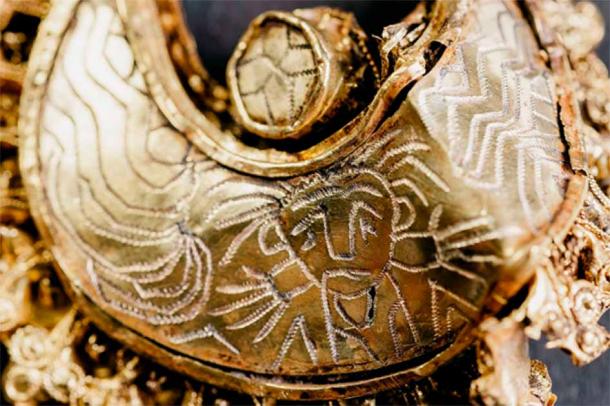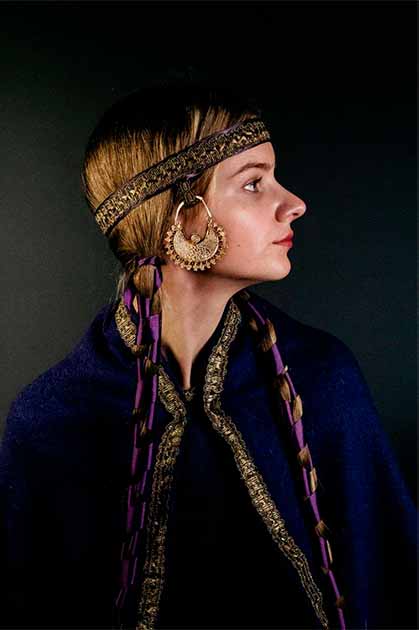
Medieval Hoard of Gold and Silver Unearthed in the Netherlands
An astonishing collection of gold and silver jewelry and coins, some of which are at least 1,000 years old, has just gone on display at the Rijksmuseum Van Oudheden (RMO) museum in the city of Leiden in the Netherlands, the Dutch News reports. The priceless precious metal treasure includes four gold ornaments shaped like earrings, two pieces of unattached gold leaf and 39 small silver coins, all of which were found in the same small plot of land.
The jewelry has been dated to the first half of the 11th century, but the coins were minted in the 13th century, which means the gold and silver items must have been buried by a collector of valuable objects who lived in the 1200s or later.
These gold and silver objects were discovered not by professional archaeologists, but by a 27-year-old historian and metal detectorist named Lorenzo Ruijter. In 2021 Mr. Ruijter was out on a treasure hunting expedition somewhere near the city of Hoogwoud, North Holland, which is located in the greater West Frisian (Friesland) region of the northwestern Netherlands. After getting a series of pings on his detector, he began digging in the earth and soon uncovered these extraordinarily rare items.
“It was just shining gold,” Ruijter recalled in an interview with NH News. “That’s just unbelievable.”
- First Roman Temples from 2,000 Years Ago Found in the Netherlands
- Stone Age Grave of a Mother and Child is the Oldest Baby Burial in the Netherlands
History is Made at Hoogwoud
While all of the objects are noteworthy, the ornaments that look like earrings stand out.
“The discovery of the earrings is of international importance,” Annemarieke Willemsen, the curator of medieval exhibits at the RMO, told the digital news service NRC. “They show that people in North Holland had contacts at the highest level around the year 1,000 and were in an international network with money.”
The four crescent-shaped ornaments were constructed from bars of 18-carat gold. There were suspension brackets attached, which adds to the impression that they were meant to be worn on the body or on clothing.
- Is this the Face of Krijn, the First Neanderthal of The Netherlands?
- Rare Ancient Dutch Castle is Bigger and Better than Expected!

Engraving of a Man's Head with Rays: A Portrait of Christ, 'Sol Invictus', the Unconquered Sun (© Archeology West-Friesland/Fleur Schinning)
One of the crescent-shaped ornaments was badly damaged, possibly by a farmer’s plow working the field where the treasure was found. But the others were remarkably well preserved, and one features the clear and unmistakable engraved image of a man whose head is enveloped in sunbeams.
“That may possibly be Christ, pictured as Sol Invictus, or the unconquered sun,” Willemsen speculated.
Two ornaments, including the damaged one, were decorated with rosettes, which were made from thin wires or filigrees of gold that have been twisted into knotted shapes. The final ornament also contained an engraved image, but its contents and meaning have yet to be determined.
While they do resemble earrings, Willemsen said that the ornaments “were probably not put through the ears, but worn on a cap or band.”
It is the style of the jewelry that dates the ornaments (and likely the gold leaf) to the 11th century. It features elements common to the northern Netherlands at that time, but also to Germany to other regions of the Holy Roman Empire.
“Hoogwoud's earrings are special because they are hybrids,” Willemsen explained. “The crescent moon shape occurs in Byzantium, we see the use of this type of filigree in the Holy Roman Empire, especially Germany, and the engravings are typical for Frisia and Scandinavia.”

Reconstruction: a woman wearing the golden ‘earrings’. (© Archeology West-Friesland/Fleur Schinning)
The cosmopolitan nature of the ornaments is why Willemsen connects them to an international trading network that passed through the lands of North Holland and West Frisia during the Middle Ages.
In their description of the just-opened display, the RMO Museum noted that the gold ornaments are especially rare. Only three similar items have previously been found during excavations in the Netherlands, and none look exactly like the newly discovered items.
As for the two gold leaf fragments, it seems they fit together like two pieces of a puzzle. Researchers say they were once part of the same headband, which would have been wound around some type of cloth hood.
“There were still fibers on the gold leaf,” Willemsen said.
The 39 small silver coins were mostly minted in three counties in the medieval Netherlands (Guelders, Cleves and Holland), although some came from the adjacent German Empire to the west.
“The youngest were struck in 1247 or 1248 under Willem II, Count of Holland and Roman King,” said Michiel Bartels, head of the organization Archeology West Friesland.
Threads of fabric were found among the coins, suggesting they’d been kept inside a cloth bag. All the gold and silver items were found within a radius of five meters of each other, causing Bartels to conclude that “they were probably buried together and the ornaments were heirlooms. Someone must have buried the treasure to keep it safe.”
Meet the Detectorist Who is Living the Dream
Lorenzo Ruijter isn’t just an amateur detectorist who just got lucky. He is a trained historian who volunteers as an archaeological assistant for Archeology West Friesland, and he specifically chose the field in Hoogwoud as a likely spot where fascinating artifacts might be found.
"That's something you develop over the years," the young historian said, describing how he chooses where to explore. "It's a combination of chance, instinct and research, I think."
Ruijter linked the gold and silver objects he unearthed to the Ottonian period, which was named after a dynasty of powerful German Saxon monarchs who ruled the Holy Roman Empire of western and northern Europe in the 10th and 11th centuries.
"Items from that time are almost non-existent,” he explained, “so in terms of objects they are very special."
To protect the sanctity of his discovery site, Ruijter has refused to disclose its exact location to the media. Even his friends and fellow detectorists have been denied this information for now.
"We saw in Ommeren that a Nazi treasure was [rumored to be] buried there," he said, referencing the recent release of a declassified World War II-era map that supposedly revealed the location of a Nazi treasure on Netherlands soil. "Everyone went there without permission, [digging] holes in the ground. It became one big mess."
While the site where the jewelry and coins were unearthed will remain a secret for now, the treasure itself will be hidden no longer. The Hoogwoud hoard display will remain open at the RMO Museum in Leiden until June 15, and it will then be opened again on October 13 as part of a larger exhibition entitled “The Year 1,000.”
Top image: The complete Hoogwoud hoard: four gold pendants, two pieces of gold leaf and 39 silver medals. Source: © Archeology West-Friesland/Fleur Schinning
By Nathan Falde
















Comments
She’s a total babe, nose and all.
LS
She’s a total babe, nose and all.
LS
If there is Nazi treasure to be had, I'm sure some modern-day, native Russian-speaking Nazi politician would be happy to claim it.
Like Volodymyr Zelenskyy...